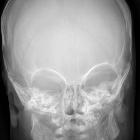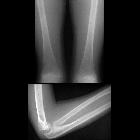generalized increased bone density in paediatrics
The causes of generalized increased bone density in pediatric patients can be divided according to a broad category of causes:
- skeletal dysplasias
- metabolic
- poisoning
- lead
- dense metaphyseal bands
- cortex and flat bones may also be slightly dense
- modelling deformities later, e.g. flask-shaped femora
- fluorosis
- more common in adults
- usually asymptomatic but may present in children with crippling stiffness and pain
- thickened cortex at the expense of the medulla
- periosteal reaction
- ossification of ligaments, tendons and interosseous membranes
- hypervitaminosis D
- slightly increased density of skull and vertebrae early, followed later by osteoporosis.
- soft-tissue calcification
- dense metaphyseal bands and widened zone of provisional calcification
- chronic hypervitaminosis A
- not before 1 year of age
- failure to thrive
- hepatosplenomegaly
- jaundice
- alopecia
- hemoptysis
- cortical thickening of long and tubular bones, especially in the feet
- subperiosteal new bone
- normal epiphyses and reduced metaphyseal density
- mandible is not affected
- lead
- idiopathic
- Caffey disease (infantile cortical hyperostosis)
- idiopathic hypercalcemia of infancy:
- probably a manifestation of hypervitaminosis D
- elfin facies
- failure to thrive
- intellectual disability
- generalized increased density or transverse dense metaphyseal bands
- increased density of the skull base
There are several mnemonics for dense bones.
See also
Siehe auch:

 Assoziationen und Differentialdiagnosen zu Generalized increased bone density in children:
Assoziationen und Differentialdiagnosen zu Generalized increased bone density in children:









